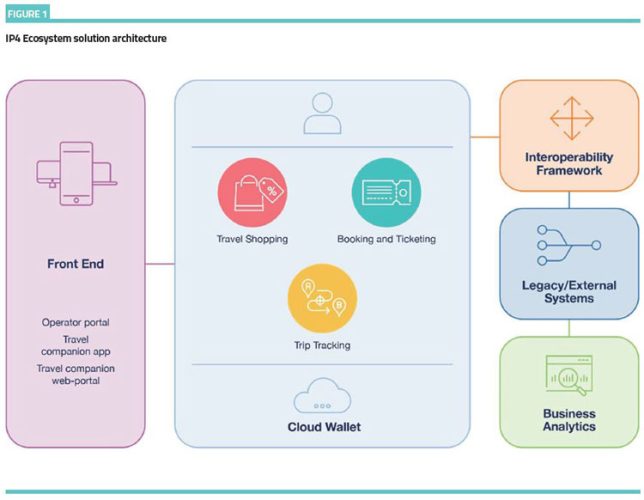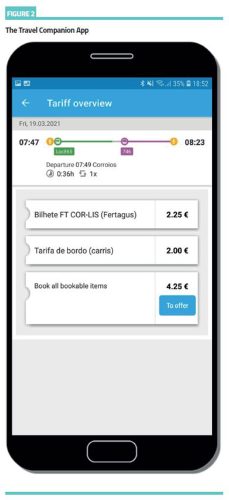Shift2Rail IP4: Removing the complexities of integrated, multimodal travel
Posted: 10 January 2023 | Joseph Cairns, Oliver Clamp | No comments yet
As the digital revolution continues to modernise the transport sector, the need to utilise technology to support people’s mobility needs is greater than ever. In this article, Network Rail’s Joseph Cairns and Oliver Clamp, explain how the Innovation Programme 4 (IP4) has taken a whole system approach to develop an ecosystem of solutions that tailors to passengers’ requirements.


Gone are the days where taking a journey would comprise of looking at a timetable on a board and hoping a train or bus turns up on time. The advancements of technology and the evolution of the smartphone over the past 10 to 15 years have allowed passengers to access a whole raft of travel information. However, despite these significant strides, multimodal travel is still limited due to ‘siloed’ markets of varying interfaces that are inefficient and isolates groups of travellers who are in desperate need of a simplified system. In most cases, passengers are still bound to visit different digital platforms in order to find the best options per transport mode, understand what transport services are available locally and manage their trip in segments directly with individual operators. Although private entities have developed tools to start to address this issue, these vary from city to city and range in what is offered to the travellers. The Innovation Programme 4 (IP4) programme, backed by the European Commission (EC), has targeted removing these barriers to demonstrate a ‘one-stop-shop’ solution can be achievable.
What is Innovation Programme 4 (IP4)?
The programme is a collaborative, co-funded research and development programme from Europe’s Rail Joint Undertaking (EU-Rail) – formerly ‘Shift2Rail’- a European-wide initiative to develop railway research that produces innovations and solutions for multiple areas including rolling stock, infrastructure and rail technology. This initiative has the objective to boost the attractiveness of rail as the backbone of the transport services, expediting its use when connecting to other transportation networks, which will contribute towards a modal shift from road to sustainable public transport. For the past five years, the programme has developed an ecosystem that aims to meet customer needs for door-to-door seamless multimodal travel, at a European-wide scale. There are six key areas that the programme selected to focus on:
1. Facilitate interoperability – Many transportation stakeholders speak different languages, which is also true for technical interfaces that provide mobility services
2. Build multimodal offers – In multimodal scenarios, it becomes difficult to calculate combined offers due to the complexity of the networks, modes of operation and different business rules for offers calculation
3. Manage bookings and tickets – Many service providers provide their own booking systems and bespoke ticketing for their respective services. In a multimodal scenario the traveller needs to manage bookings, tickets, and payments with different entities
4. Optimise information for the traveller – There is a variety of different sources of information of transportation networks and systems, with varying interfaces, but there is no single place that could provide combined information about an individual journey
5. Build and enable Travel Companion tools – All the mobility services should be easily accessible on the go, through a mobile app, website, or other wearable devices
6. Create value from mobility data – Having a multimodal ecosystem could lead to extra value created from the usage of different sources of data.


Whole system approach
For a singular solution to work effectively, the system must support the needs of both the traveller, to optimise and enhance their travelling experience, and the operators/transport service providers, for whom there is an opportunity to optimise and tailor their services based on data trends. With this in mind, the IP4 consortium have developed a mobile app and web-based system that is the passenger interface to the ecosystem, known as the ‘Travel Companion’, and the ‘Business Analytics’ portal that is the operator interface which offers a platform for data analytics and visualisation, asset management and a customer response management space.
a) Solutions for passengers
The Travel Companion has been developed to offer solutions to the traveller before, during, and after their trip. This means that the system provides a passenger the functionalities to facilitate any journey, including:
- Journey Planning using all modes including bike-sharing and walking for first-mile, last-mile segments of journeys
- Travel Shopping based on customisable individual preferences, such as coach class or preferred mode options
- Booking and Ticketing that removes the complexities of collecting valid permits of travel via different modes, operators, regions, and countries and offering a single digital ticket that is valid for the complete journey regardless of mode or operator
- Trip Tracking which monitors European traffic irregularities and transport system failures to match them to the journeys of passengers using the ecosystem, aiming to inform about disruption to their journeys in real-time and to suggest alternative routing options.
As well as the core components required to book and make a journey, the programme also focuses on features that aim to enhance a passenger’s experience when travelling, including dynamic mapping displays where Points of Interest (POIs) are highlighted and a virtual reality feature for enabled glasses and headsets that can navigate travellers to key locations, gates, and platforms in transport hubs.
b) Solutions for operators
With increasing transport data being generated, there is a great opportunity for providers and operators to utilise and analyse data to provide useful information and to deliver an optimal service for passengers. This is especially poignant in recent times where the COVID-19 pandemic caused a seismic shift in travelling needs and behaviours, and a need to understand the new demand requirement and travel patterns. The Business Analytics suite utilises Descriptive, Predictive and Prescriptive analytical techniques based on passenger and operational data that allows operators to better understand travel habits and trends and service quality to tailor and improve performance and presents the information through interactive and visual dashboards. The system’s also support a secure Cloud-based platform that manages user data required by transport providers such as profile preferences and to issue bespoke tickets.
A recent case study highlighted the potential of tailored service based on effective data analysis. Data was collected from over eight million rental trips between January 2018 and March 2020 of the bike-sharing scheme ‘BiciMAD’ in Madrid, Spain. Data collected was able to identify a variety of useful metrics, such as least and most used routes and locations, hourly demand and disparities in demand and supply at origins and destinations. This analysis was able to help the operator modify distribution by identifying locations that would benefit from additional bikes and reducing in areas that had an unnecessary surplus, hence increasing utilisation and satisfaction overall.
Interoperability Framework
Interoperability is critical to the success of integrating transport for whole journey facilitation, hence a lot of focus of the programme has been on creating a system that will allow a seamless integration with minimal effort. The ‘Interoperability Framework’ (IF) overcomes the complexity of interoperability across heterogeneous distributed systems by using semantic interoperability technology. This results in the ability for all transport providers and operators to connect all relevant data to the IP4 ecosystem, such as location, fare offerings, and trip tracking data, regardless of language or format. The orchestrators (i.e., travel shopping, trip tracking, etc) will be able to present and use the operator’s data in the IP4 ecosystem’s language via the IF without the operators having to do any changes on their legacy system or new software developments for interface adaptations.
Outcomes and scalability challengers


The purpose of the programme set out by the European Commission was to create working outputs to Technology Readiness Level (TRL) 7, which has been successfully achieved this year through pilots in Athens, Helsinki, and Brno, with a further six locations planned in 2023, and an integrated technological demonstrator at the September InnoTrans 2022 fair in Berlin. TRL7, however, is not a level at which the system is ready for commercialisation and deployment and the adoption of a single, European-wide system presents multiple challenges on both technical and commercial fronts.
Ownership is an initial dilemma. Private enterprises or infrastructure managers have ownership potential; however the consortium’s view is that national transport organisations that are state owned or partially state owned are likely to be best placed to manage the ecosystem. A lack of standardisation across the industry, the sheer volume of transport service providers across Europe and the frequency flow of technical updates from different providers will require the owner to be sufficiently resourced and have adequate governance processes to manage the ecosystem effectively. As well as the ‘who’, ‘what’ is another key decision. What structure will the platform take? Some initial research into some potential options has been started, such as one IP4 platform connecting to external Mobility-as-a-Service (MaaS) aggregators, or a hierarchical structured platform segregated into multiple national, regional, or local platforms, however each possible option will need to be assessed in detail against factors such as technical practicalities, advantages and drawbacks and cost.
Data acquisition has also been a major issue for the duration of the programme. Unless there are significant changes in legislative policy around travel data, many operators are not inclined to provide access to their commercially/operationally sensitive data unless there are worthwhile incentives to do so. Additionally, there is also a consideration of the many applications that already offer multimodal travel information and management, what will become of these? Will they collaborate or become a direct competitor with a fight to secure transport data at premium prices?
We believe one thing is for sure; a one‑stop‑shop solution is the future and will be crucial in incentivising people to ditch their private use vehicles for public transport as we look towards a greener, more sustainable horizon. The opportunity is there, we just need to make it an easy and simple choice.
These research works have received funding from the Shift2Rail Joint Undertaking under the European Union’s Horizon 2020 grant agreement no 101015462 (‘ExtenSive’ project). Thecontent of this report does not reflect the official opinion of the Shift2Rail Joint Undertaking (S2R JU) and the responsibility for the information and views expressed in the therein lies entirely with the author(s).


Joseph Cairns is a Project Manager from Network Rail with over five years’ experience. As well as working on European R&D projects, he also has experience in railway asset protection in the UK construction industry and development of strategic capacity improvement solutions, supporting outline and final business cases for infrastructure projects. Prior to joining the railway industry, Joseph worked as a ground surveyor in the UK, Europe and the Middle East and holds an MSci honours Geophysics degree from the University of Southampton.


Oliver Clamp is a Project Manager at Network Rail who has recently joined the COHESIVE, ExtenSive and CONNECTIVE projects from Shift2Rail’s IP2, where he led several traffic management demonstrators in collaboration with various European partners. Oliver is responsible for the dissemination activities of the three in-flight IP4 projects, working to ensure that the outputs from this programme are well communicated to potential consumers.
Issue
Related topics
Apps, Big Data, Passenger Experience/Satisfaction, Technology & Software








